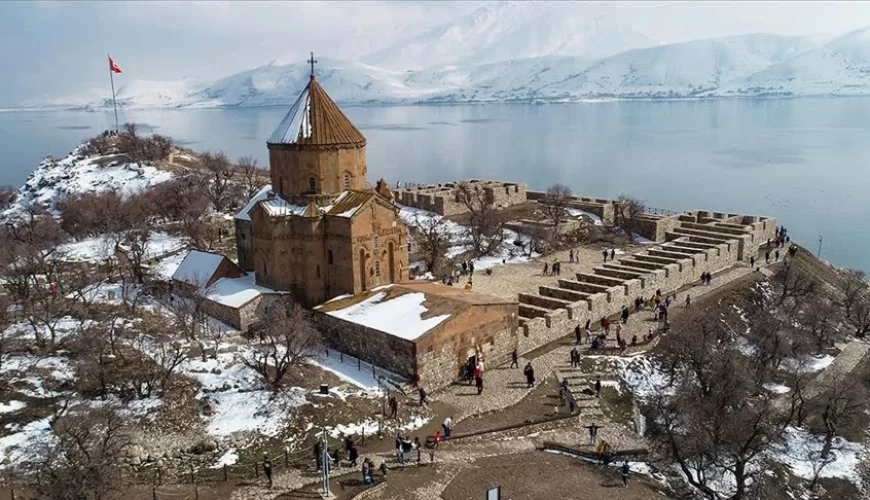Akdamar Island, also known as Aghtamar or Akhtamar is the second largest of the four islands in Lake Van, in eastern Turkey. About 0.7 km² in size, it is situated approximately 3 km from the shoreline. At the western end of the island, a hard, grey, limestone cliff rises 80 m above the lake’s level (1,912 m above sea level). The island declines to the east to a level site where a spring provides ample water.
It is home to the 10th century Armenian Holy Cross Cathedral, which was the seat of the Armenian Apostolic Catholicosate of Aghtamar from 1116 to 1895.
The origin and meaning of the island’s name is unknown, but a folk etymology explanation exists, based on an old Armenian legend. According to the tale, an Armenian princess named Tamar lived on the island and was in love with a commoner. This boy would swim from the shore to the island each night, guided by a light she lit for him. Her father learned of the boy’s visits. One night, as she waited for her lover to arrive, her father smashed her light, leaving the boy in the middle of the lake without a guide to indicate which direction to swim. He drowned and his body washed ashore and, as the legend concludes, it appeared as if the words “Akh, Tamar” (Oh, Tamar) were frozen on his lips. The legend was the inspiration for a well-known 1891 poem by Hovhannes Tumanyan.
The similar-sounding Akdamar (meaning “white vein” in Turkish) has since become the official name of the island.
During his reign, King Gagik I Artsruni (r. 908-943/944) of the Armenian Kingdom of Vaspurakan chose the island as one of his residences. He founded a settlement and erected a large square palace richly decorated with frescoes, built a dock noted for its complex hydrotechnical engineering, laid out streets, gardens, and orchards, and planted trees and designed areas of recreation for himself and his court. The only surviving structure from that period is the Palatine Cathedral of the Holy Cross. It was built of pink volcanic tuff by the architect-monk Manuel during the years 915-921, with an interior measuring 14.80m × 11.5m and the dome reaching 20.40m above ground. In later centuries, and until 1915, it formed part of a monastic complex, the ruins of which can still be seen to the south of the church.
Between 1116 and 1895 the island was the location of the Catholicosate of Aghtamar of the Armenian Apostolic Church. Khachatur III, who died in 1895, was the last Catholicos of Aght’amar. On August 28, 2010, a small solar energy power plant was opened on the island, to provide local installations with electricity.











Comment (0)